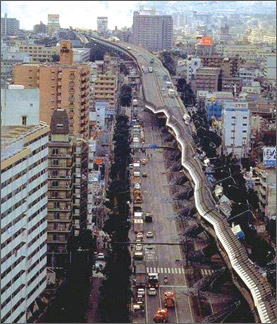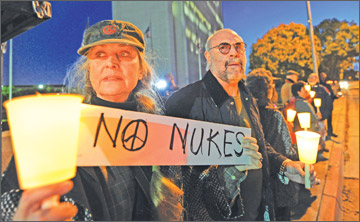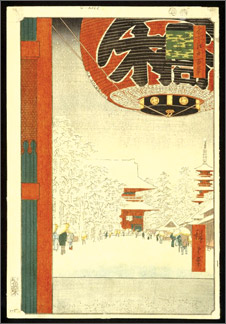Price of power
Brij TANKHA
Japan’s centuries-old experience in dealing
with natural disasters proves inadequate to help it handle the man-made
nuclear crisis.
 |
 |
| January 17,
1995, Kobe: A collapsed elevated highway after a 7.02 magnitude
earthquake rocked western Japan |
South Korea
environmental activists wear masks and yellow raincoats during a
demonstration to oppose nuclear power at a shopping district in
Seoul on March 29, 2011. AFP |
The magnitude 9.0 earthquake of March 11, the 10-metre-high waves of
tsunami that followed, and the aftershocks have left Japan devastated,
with thousands dead and radiation from damaged nuclear power plants
threatening to endanger more lives. Both the Japanese people and
Government have indeed learnt to deal with natural disasters, of which
they have a long historical experience. But the question is: can they
deal with the collapse of their man-made systems?
The damage to the Fukushima nuclear power plant and the unfolding
dangers thereof lie at the heart of the dilemma of living in a dangerous
geological zone, balancing growth and safety. How far can one insulate
oneself from disaster and at what cost?
Dealing with natural disasters such as earthquakes, tsunamis or
volcanic eruptions, singly or together, is something the Japanese have
done for centuries. Rather than reacting with merely stoic acceptance,
they have developed systems to respond to and mitigate the effects of
disasters.
Lessons from the past
Frequent earthquakes led them to construct buildings with lightweight
materials such as wood and paper, and their cities had large open spaces
not for assembly but to act as fire breaks; earthquakes inevitably led
to fires - the ‘flowers of Edo’ (the old name of Tokyo) as they were
called.
Also, a high degree of literacy, a vibrant publishing culture and a
well-developed transport system allowed for quick dissemination of
information.

Anti-nuclear demonstrators hold a candlelight vigil to protest
against nuclear power outside the Federal Building in Los
Angeles on March 28, 2011. AFP |
Between 1854 and 1860, in what is called the Ansei period, three
major earthquakes and some 120 minor ones struck the region around Tokyo
and the island of Kyushu, killing thousands and causing widespread
destruction. In March 1854, the Japanese concluded a treaty with the
United States and allowed it to open a consulate in the coastal town of
Shimoda, near the capital. The large-scale destruction of the capital
city in earthquakes that year and subsequently was ascribed by many to
divine retribution for allowing foreigners entry into Japan.
The first earthquake struck in December that year, and the subsequent
ones and the social turmoil that followed gave rise to a whole genre of
paintings - woodblock prints of giant catfish (namazu-e), which became
very popular. The giant catfish, it was believed, lay under the earth,
supporting the world, and its thrashing caused earthquakes (only in the
1960s scientists did identify plate tectonics as the cause). These
colourful posters, the popular media of the day, served many functions.
They not only spread images of the destruction caused but also
questioned the role of the authorities and their policies, even as they
turned in a tidy profit for the artists and the publishers.
The woodblock prints also served to show the triumph over disaster. A
well-known series of woodblock prints, The Hundred Views of Edo by the
famous artist Ando Hiroshige (1797-1858), were in fact commissioned by
then unknown fishmonger-turned-publisher to show the rebuilding of the
capital after the Ansei earthquake.
Incidentally, Hiroshige himself came from a family that was employed
to protect the castle from fires, and he too was similarly employed as
the fires that followed the earthquake took an even greater toll than
the earthquake itself. The city wards maintained trained firefighting
teams that performed drills regularly and wore uniforms with their
monograms so they could identify each other in the confusion.
Watchtowers were erected at strategic points and they had both lookouts
and firefighters.
Hiroshige showed the great landmarks of the city, such as the Asakusa
Kinryuzan temple where its reconstructed pagoda stood in all its glory.
The pagoda was rebuilt within seven months.
The cherry blossom appears in many of his prints as a symbol of the
regeneration of the city. Later, it was transformed into a symbol of
nationalist glory. Publishers profited from the sales, and Hiroshige’s
prints went on to attain iconic status, influencing artists around the
world. Vincent van Gogh is said to have made copies of some of them.
Today, it will undoubtedly take time and money to restore the towns and
hamlets that have been devastated, but the Japanese have the experience
and the technologies to do it.
Civil society action
 |
 |
| At
Higashimatsushima city in Miyagi prefecture on March 13,
soldiers remove a body from the debris of buildings and piled-up
cars |
A view
of the pagoda at the Asakusa Kinryuzan temple rebuilt after it
was destroyed in a massive earthquake, in this copy of a
woodblock print by Ando Hiroshige |
The great calm and the well-trained response in the face of the
present disaster have been much talked about. Social discipline is not
something inherently peculiar to the Japanese, rather it has been
created through training and education. Following the great Kanto
earthquake of September 1, 1923, when nearly 1,50,000 people died -
again mostly in the fires that broke out after the quake and which were
fanned by a typhoon that struck soon after - rumours, many carried as
fact in news reports, that ethnic Koreans were looting and rioting led
to vigilante groups murdering anyone thought to be Korean.
Along with them, socialists and other political radicals were also
targeted. The earthquake and the social disruption left a deep scar,
which is why, in 1960, September 1 was declared Disaster Prevention Day.
On this day, schools all over the country carry out disaster prevention
drills, which have helped people, respond in an orderly manner.
This time the Government’s response was swift, and it accepted offers
of help from other countries quickly, a lesson perhaps learned from the
January 17, 1995, Kobe earthquake, when the Government was slow to
respond and it took the Japan Self-Defence Forces (JSDF) more than two
hours to move. Moreover, the Government refused offers of help from
other countries on the somewhat specious excuse that since foreign
rescue workers would not have Japanese medical degrees they could not
work in Japan.
The 1995 disaster also exposed the problems in earthquake warning
systems and building standards. The major damage was in urban areas,
with the collapse of roads and buildings. Building standards and
construction techniques were suitably modified. However, the estimated
cost of the damage was over $ 100 billion, or around 2.5 percent of the
then gross domestic product (GDP). Kobe, though mostly rebuilt, has
never quite recovered its position as the pre-eminent port of Japan.
The Kobe earthquake was also a major turning point in terms of the
vigorous response of civil society groups - even private retail chains
came forward to help. Chain stores used their retail networks to deliver
food to affected areas, and volunteers, in the care they provided,
served to catalyse the dormant volunteer movement in Japan. In
recognition of their services, the Government declared January 17 as
National Disaster Prevention and Volunteerism Day.
Providing care
Kobe came as a wake-up call for the Government to make significant
changes in its response system and to ensure better safeguards in
buildings and other structures so that they were more resistant. In the
present case, the damage in urban areas such as Tokyo has been limited
and most of the destruction has been from the tsunami that followed the
earthquake.
The destruction has been severe in the coastal regions of Miyagi and
Iwate, which, except for the densely populated city of Sendai, have a
scattered population. These largely rural areas, where the average age
is probably around 66 years, are dotted with hamlets, many of which have
been wiped out by the tsunami. The death roll is mounting and the actual
figures will be known only after the mountains of debris are cleared and
the rescue work is over.
The number of homeless is estimated at some half a million, a figure
that is bound to increase. Many of these people, given the demographic
profile of Japan as an aging society, will be old. Reports have come in
about how difficult it was for many of them to cope in the melee that
followed as the tsunami came in.
These people will have to be housed and fed and provided with medical
care for a considerable period before their homes and towns are rebuilt,
and that will be the challenge. Amongst them will be immigrants from
China and Korea and other nations, given the factories in the area.
Caregivers are in short supply, and the Government will have to loosen
its regulations to allow foreign workers to fill this need. Perhaps the
Indian government could think of providing medical aid and after-care
services.
The response this time shows that Japan has learnt a lot from the
past. It has responded quickly, and to underline the seriousness of the
crisis, Prime Minister Naoto Kan called it the worst disaster since the
end of the Second World War. The Emperor made an unprecedented speech
underlining the scale of the disaster.
International teams are operating on the ground, and the
international media are there in force. Of course, for a nation as
obsessed with the camera as Japan, the deluge of photographs and videos
of the disaster as it unfolded provides a dramatic and disturbing view
of events, conveying a sense of immediacy rarely seen in the past.
Pictures of the mud-laden tsunami engulfing houses and carrying away
cars and even ships will remain etched in many minds as will be the
frightening images of people waving from buildings or dashing down
roads, probably seconds before they were engulfed by the
mud-and-debris-laden tsunami.
The Frontline |



